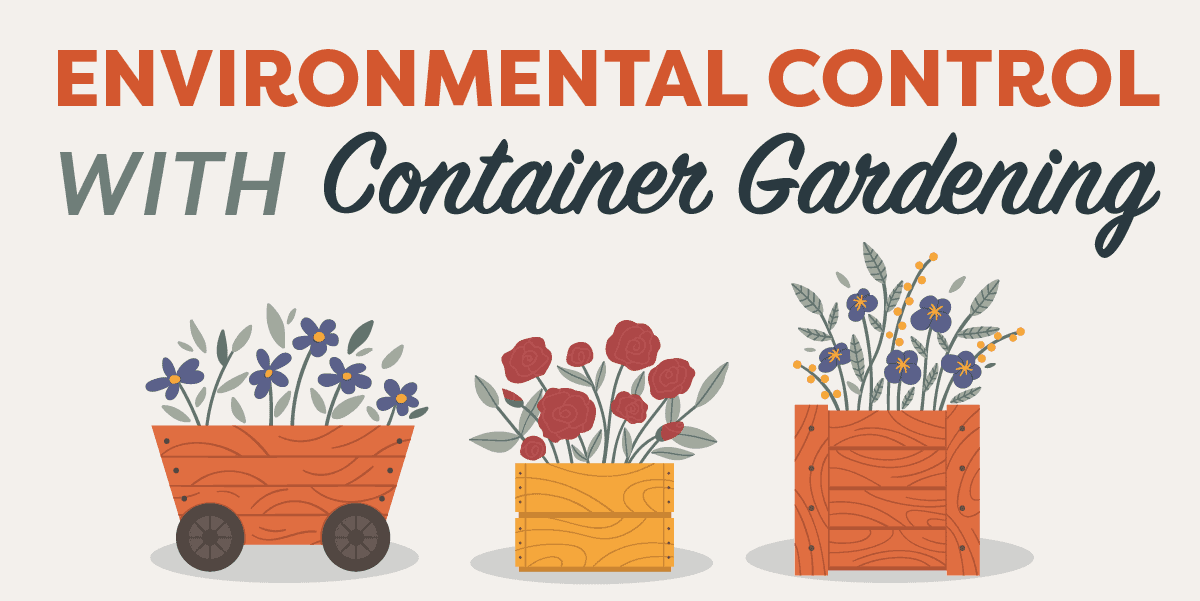Containers let you control a plant’s environment, that is, the “soil” (potting mix), moisture, location (relative to sunlight and wind), temperature, and weed prevention.
That’s the advantage over conventional gardening, which leaves you at the mercy of the elements. In Southern California, we’re talking about droughts and sometimes brutal summer sun.
The art of container gardening is hundreds of years old. Farmers, horticulturalists, and enthusiasts have grown plants in window boxes, small indoor pots, and large containers for landscaping.
Landscape and vegetable container gardening is booming. Nearly everyone, including apartment dwellers and gardeners with limited space, can practice it. Container gardening offers flexibility and obtains maximum production from flower and vegetable plants.
Containers are suitable for flower cultivation, vegetables, herbs, small to medium-sized shrubs, and even dwarf trees.
You can rotate container crops seasonally, just as in the garden.
Choosing Your Container
The most efficient containers have a water reservoir at the bottom, a cover over the potting mix, and a wick into the water. These self-watering planters don’t require additional water as often as conventional pots and deliver the correct amount of moisture to plant roots.
If you decide to go in another direction, look for these features in a container for gardening:
- Drainage holes
- Lightweight materials (plastic, fiberglass, or foam) for easy moving
- Adequate size to accommodate the plant’s root system
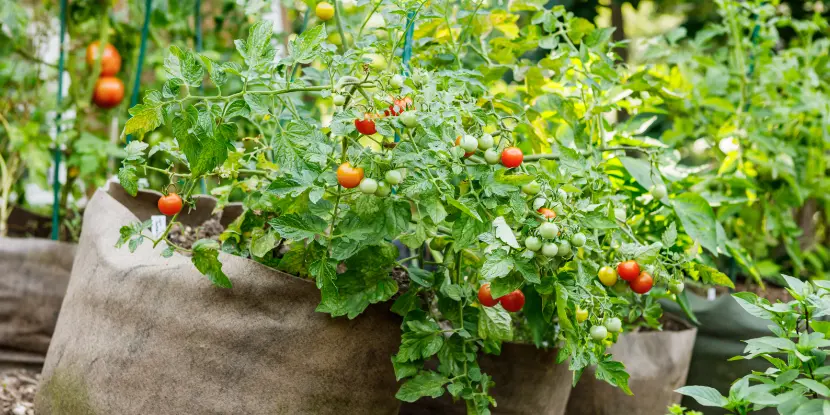
Cherry tomatoes grown in burlap sacks. Use your imagination!
Clay pots are a good choice for plants that don’t require much moisture, such as succulents.
You can buy or build containers for special needs. Garden supply centers have traditional units, some with special features and designs. Other suitable types with drainage holes are buckets, baskets, 30-or 55-gallon drums, cans, tubs, sacks, boxes, half-barrels, etc.
Another idea is to hang a bucket from a high hook or beam with a tomato plant growing from the bottom.
The size container for beets, carrots, Swiss chard, lettuce, onions, and radishes should be at least a 1-gallon; 2 gallons for beans, mustard, and turnips; 3 gallons for peppers, and 5 gallons or more for all larger plants according to their expected mature root system.
Below: Growing tomatoes in pots.
Choosing Your Potting Mix
Garden soils tend to be heavy, compacted, and unsterile, and they can contain pathogens. Opt for a high-quality potting mix.
The best potting mixes have:
- Good aeration: Soilless mixes (peat moss-based with perlite or vermiculite) are often good choices because peat retains water but drains well.
- Nutrients: Look for slow-release fertilizer in the mix or add it yourself.
- Moisture-holding polymers: These help retain moisture in the mix.
- Good drainage: Use an airy, well-drained, and not too heavy mix.
- Low compaction: A light potting mix is best for plant roots.
If you’re using conventional soil (e.g., compost) in the mix, sterilize it first. Otherwise, bacteria and fungi could harm your plants.
Gardeners often make their own mixes to save money or customize the mix for specific plants. For example, succulents and cacti need good drainage; thus, you can add coarse sand or perlite to a standard potting mix to create one that suits them.
You can search online for good mix recipes. Reputable resources include gardening forums, university extension services (cooperative extensions), and gardening magazines.
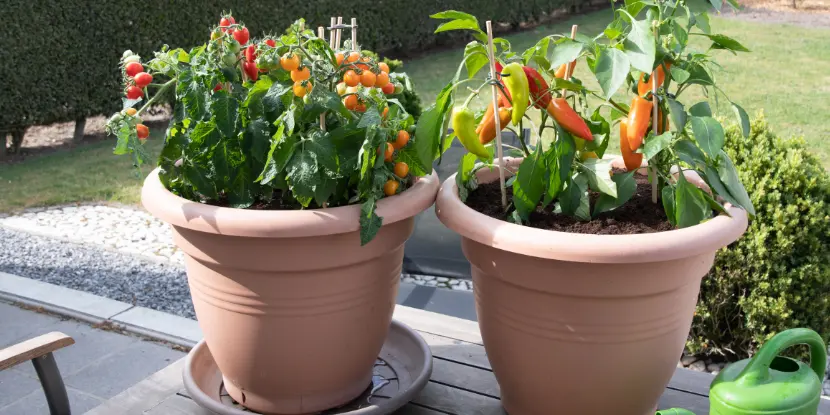
Potted peppers and cherry tomatoes growing on a table outdoors.
Transplanting Your Container Plants
We recommend starting with healthy transplants rather than sowing seeds. Most flowers and vegetables should be transplanted when they develop their first two or three true leaves. Avoid touching the hairs on the stems of small plants.
- Transplant in the early morning or late afternoon to avoid the harsh midday sun.
- Water seedlings and their new container soil thoroughly to reduce transplant shock.
- Handle seedlings by their leaves, not stems. The stems are delicate and easily damaged.
- Make holes in the new container’s soil large enough to comfortably fit the seedling’s root ball without bending the roots.
- Plant seedlings at the same depth they grew in their original containers. Some plants, like tomatoes, can be planted deeper to encourage root growth along the buried stem.
- Gently firm the soil around the roots to eliminate air pockets and provide support.
- Gently water the transplanted seedlings to settle the soil and help establish the roots.
- Shield newly transplanted seedlings from strong winds, heavy rain, and direct sunlight for a few days.
Caring for Your Container Plants
Temperature
You can place your potted plants almost anywhere: indoors or outdoors, on racks, brackets, benches, and purpose-built structures, or hanging from beams to protect them from animals.
Summer soil can be considerably hotter than air temperatures. During the warmest months, move potted plants to plastic pipes or other materials that won’t transfer heat into the potting mix. Even wood can transfer a surprising amount of heat, as anyone who has measured summer deck temperatures will attest.
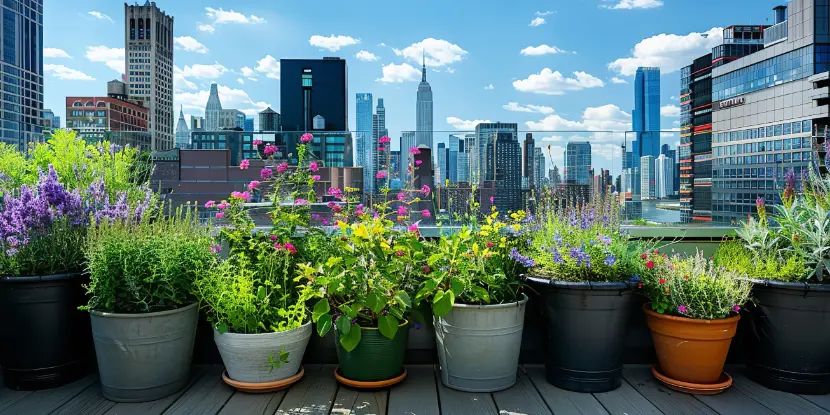
Even urban apartment dwellers can practice container gardening.
More Temperature Considerations
- Ensure the temperature doesn’t drop too low at night, especially for tropical plants.
- For areas that experience frost, consider bringing potted plants indoors or covering them with protective materials like frost cloths.
- On sweltering days, shade your plants during the peak sun hours.
- Avoid extreme temperature fluctuations by positioning your containers in areas that benefit from stable microclimates, such as near walls or fences.
- Strong winds can cause sharp temperature drops; use windbreaks or reposition containers for protection.
Sunlight
- Position sun-loving plants like tomatoes, peppers, and roses in areas where they’ll receive at least 6–8 hours of direct sunlight daily.
- Plants like lettuce, spinach, and some flowers prefer 3–6 hours of sunlight, ideally during the cooler parts of the day (morning or late afternoon).
- For indoor or shaded garden areas, select plants like ferns, ivy, or snake plants that thrive in low- to medium-light conditions.
- Regularly rotate containers to ensure even sunlight exposure and prevent lopsided growth.
- Be mindful of seasonal changes in sunlight patterns and adjust the placement of containers accordingly.
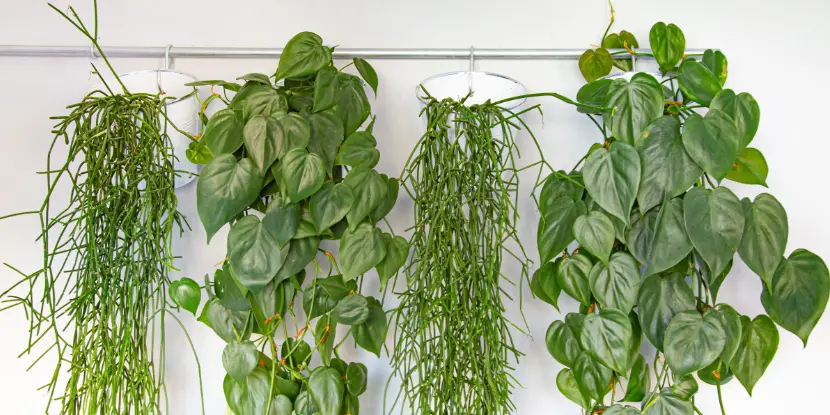
Hanging ornamental plants growing in buckets.
Water
Most gardeners agree that overwatering is the most harmful mistake in container gardening. Container soil dries out faster than ground soil, so watering should be more frequent. However, plants don’t like soggy roots.
- Rainwater is the best source of moisture.
- Before watering, test the soil moisture by sticking your finger an inch into the potting mix. If it feels dry, it’s time to water.
- Saturate the potting mix. Water should flow out of the drainage holes.
- If your container has a saucer or tray underneath, empty it after watering to prevent roots from sitting in stagnant water.
- Look for signs of overwatering, like yellow leaves, moldy soil surface, or a musty smell. If detected, reduce the watering frequency.
- Different plants have different water needs. Succulents need less frequent watering, while vegetables and flowering plants may require more attention.
- If using self-watering containers, make sure the reservoir is filled and the wick system functions correctly.
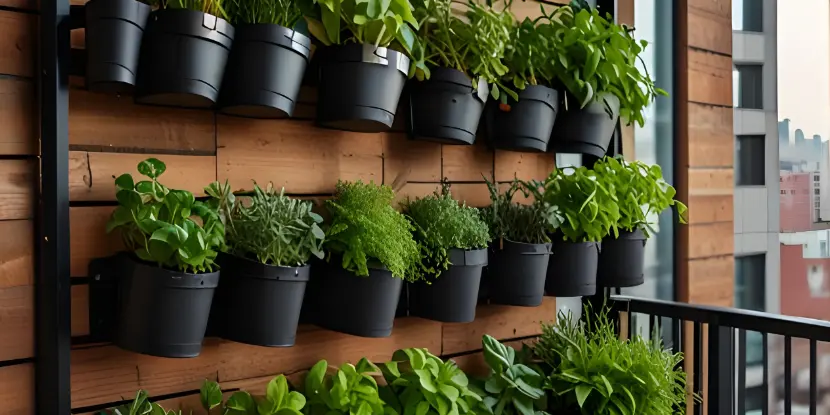
A vertical container garden mounted on a balcony wall.
Fertilizer Tips
Here’s how to ensure your container plants receive the right amount of nutrients:
- Use a balanced, water-soluble fertilizer that provides immediate nutrients.
- Apply fertilizer at regular intervals. Follow the schedule recommended on the fertilizer packaging, usually every 2-4 weeks during the growing season.
- Dilute concentrated fertilizers. Use them at half the recommended strength to avoid burning the plant’s roots.
- Incorporate slow-release fertilizers. Mix them into the potting mix at planting time for a steady supply of nutrients over several months.
- Watch for signs of nutrient deficiency. Yellowing leaves, stunted growth, or poor flowering can indicate a lack of nutrients. Adjust your fertilizing regimen accordingly.
- Avoid over-fertilizing. Excess fertilizer can lead to nutrient imbalances and root damage. Less is preferable to more.
- Rinse the soil periodically. Occasionally, deep water your containers to flush out accumulated salts.
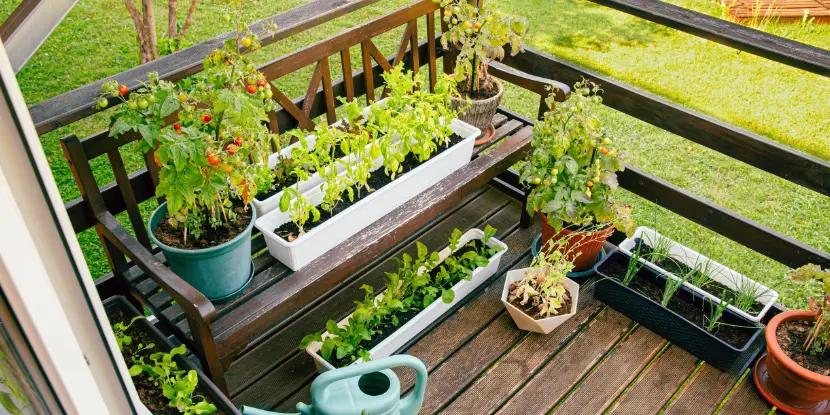
A compact container garden on a porch.
Pests & Diseases
- Maintain healthy plants through proper watering, feeding, and sunlight exposure. Healthy plants are less susceptible to pests and diseases.
- Keep the area around your containers clean and free of debris. Remove any fallen leaves or plant material that can harbor pests and diseases.
- Ensure adequate space between plants to improve air circulation and reduce the likelihood of fungal diseases.
- Encourage beneficial insects like ladybugs and predatory beetles, which help control pest populations.
- Treat infestations with natural remedies like neem oil or insecticidal soap. These methods are less harmful to the environment and beneficial insects.
- Avoid planting the same type of plants in the same containers each season to reduce the build-up of soil-borne diseases and pests.
- Water plants at the base rather than from above to keep foliage dry and minimize fungal infections. Water early in the day to ensure foliage dries before nightfall.
- Always use clean, sterilized tools to prevent the spread of pests and diseases between plants.
- If a plant is severely infected, remove and dispose of it to prevent the spread to other plants.
- Choose plant varieties known for their resistance to common pests and diseases.
Conclusion
If you’ve made it this far, you’re either extremely thorough and persistent or raring to go!
Try to “contain” your excitement!
Container gardening is a scalable and infectious exercise. Start with a few indoor or patio plants, and you may find that your newfound plant passion has you making weekly trips to the nursery to buy new specimens for your garden menagerie.
And if you live in Los Angeles, we at Anawalt Lumber welcome your business. Please visit us to talk to one of our garden specialists and view our selection of plants, containers, potting mixes, fertilizers, tools, and more.
And as usual, we invite you to share your gardening success on Facebook and Instagram.
Happy gardening!
FAQs: Container Gardening Essentials
Q: What’s a short definition of ‘container gardening?’
Container gardening involves growing plants, including flowers, herbs, and vegetables, in containers instead of planting them directly in the ground. It’s a form of gardening that can be adapted to various spaces and environments.
Q: What types of containers can I use for container gardening?
You can use pots, planters, hanging baskets, and even upcycled boots, barrels, or buckets, as long as they’re clean and have adequate drainage.
Q: Can all plants be grown in containers?
Most plants can be grown in containers, but some will do better than others. Always research the plant’s needs and consider factors like the size of the container, soil type, and water requirements.
Q: How often should I water my container plants?
The watering frequency depends on the type of plants, the size of the container, and the environmental conditions. Generally, container plants need more frequent watering than those in the ground since the soil in containers dries out faster.
Q: Do container plants need special soil?
A potting mix designed for container gardening is best. Unlike regular garden soil, these mixes are formulated to provide proper aeration, drainage, and nutrients to the plants.
Q: How do I choose the right size container for my plants?
The container size should correspond to the size of the plant at maturity. Smaller plants like herbs can flourish in smaller pots, while larger vegetables and flowers may need larger pots to accommodate their root growth.
Q: Can I practice container gardening?
Many plants thrive indoors in containers with enough light, water, and nutrients. Herbs, succulents, and many ornamental plants are well-suited to indoor container gardening.
Q: How should I fertilize my container plants?
Container plants typically require more frequent feeding than those in the ground. Use a water-soluble fertilizer every couple of weeks, following the label instructions.
Q: What are the best plants for a beginner to start with?
Herbs like basil, mint, and parsley are excellent starters for beginners. They’re easy to grow and adaptable to container gardening. Cherry tomatoes, lettuce, and radishes are also good options for novice gardeners.
Q: How can I prevent pests in my container garden?
Regular monitoring and plant health are critical for pest prevention. Natural remedies like neem oil, insecticidal soaps, and barriers can also manage pests.
Q: Do I need to repot my plants as they grow?
Plants may outgrow their containers. Watch for signs like roots emerging from drainage holes or slowed growth.
Q: Can container gardening save me money?
Vegetable and fruit gardening can lower your grocery bills. Growing your herbs and flowers can also save you money on store-bought plants and cut flowers.
Q: Where can I purchase containers, soil, and other materials for container gardening?
Many nurseries, garden centers, and hardware stores carry containers, potting mixes, fertilizers, tools, and more designed for container gardening. Online retailers also offer a wide selection of these items. And if you live in the Los Angeles area, visit us at Anawalt Lumber & Hardware!

